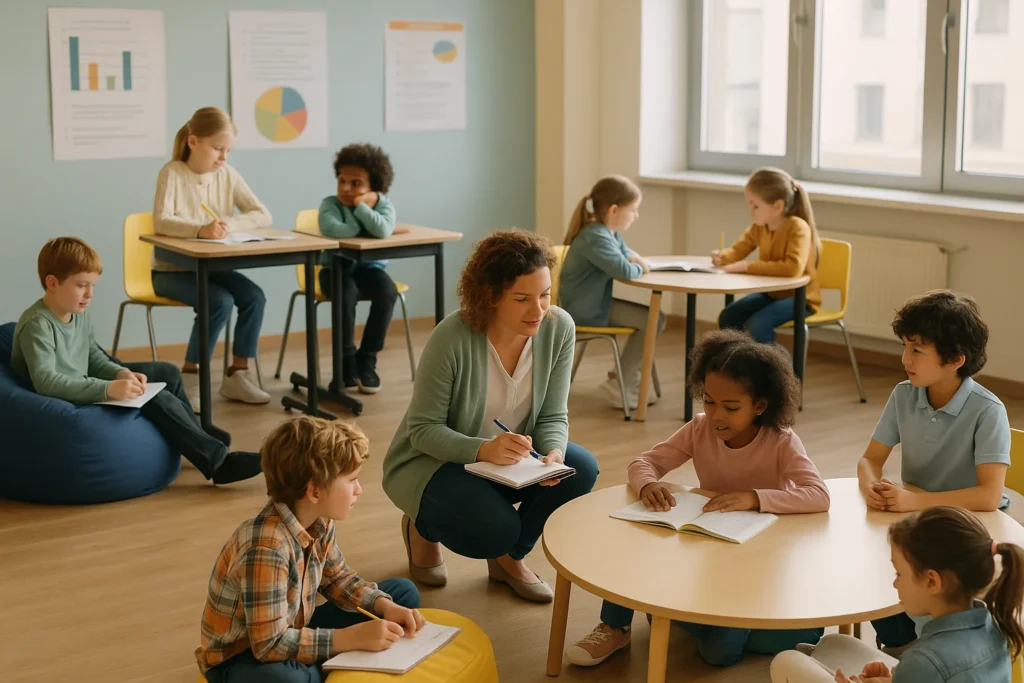Teachers today are overwhelmed by the demand to adapt to various learning styles and produce measurable outcomes, often with minimal time and support.
Everyone talks about how classroom technology can help solve these problems. But when you’re already juggling so much, adopting a new method feels like another mountain you have to climb.
So in this post, we’ll walk you through what works in classrooms and what doesn’t. We’ll explore common worries about classroom tech and how to use it to support students without increasing your workload.
First, we’ll see how tech can make learning more effective.
How Classroom Technology Improves the Learning Experience

Technology is changing everything about how kids learn today. Digital tools help students learn better and give teachers ways to engage every student.
So what does this actually look like in practice?
Real-Time Feedback and Student Progress
Imagine getting your quiz results weeks after you’ve moved on to the next unit. That’s how things used to work before technology became the norm. Now, digital platforms show you immediately how each student is doing by recording every quiz and assignment automatically.
This instant feedback can help you see which students are struggling before they fall too far behind.
Tools like Google Classroom make this tracking even more simple. Students can see their own progress over time, which can motivate them to keep pushing forward.
Boosting Student Engagement
Let’s be honest, reading from a textbook for an hour puts most kids to sleep. Interactive tools solve this problem by keeping students engaged through educational apps, videos, and games that make learning more fun.
The numbers back this up too. A study found in the Journal of Education for Business shows 67% of students say gamified lessons motivate them more than regular classes.
Plus, different students learn differently, which technology has also adapted to. For instance, some kids learn best by seeing things visually, while others learn better through hands-on activities. Digital tools can support both by including videos, interactive simulations, and practical exercises in one lesson.
Reducing Teacher Workload
Want to know what teachers really need? The answer is more time, and technology can give it to them by handling the boring tasks, like grading simple quizzes, tracking attendance, and organizing materials automatically.
AI tools can help with other repetitive tasks, too, like lesson planning and content creation. This means you spend less time on paperwork and more time actually connecting with your students.
The best part? Your school already has these tools available. Platforms like Microsoft 365 and Google Workspace include AI features now that automate common tasks.
These benefits sound promising, but how do you match the right technology to each student’s unique way of learning?
Matching Digital Technologies to Diverse Learning Styles

As we mentioned earlier, classrooms are full of students with unique learning styles. So let’s find out how you can use digital tools to help every student learn in their own way.
Visual, Auditory, and Kinesthetic Learners
Visual learners need to see concepts upfront to grasp them. These are the students who remember diagrams and charts better than spoken instructions. So videos, infographics, and interactive whiteboards will work brilliantly for them. Even simple PowerPoint presentations with clear images can help these kids connect ideas visually.
Then you have auditory learners who absorb information best through listening. We recommend using podcasts, audiobooks, and recorded lectures to explain your topics efficiently.
For younger students, apps like Me Books help them hear stories read aloud while following along on screen. This combination strengthens both their listening and reading skills at the same time.
Now, kinesthetic learners are different. They thrive when they can move around and interact directly with the material. Interactive simulations and hands-on digital activities can keep these students engaged.
Personalised Learning Tools
Adaptive platforms take things even further by customising content for each student. These smart systems watch how a student performs and adjust automatically.
Struggling with fractions? The platform gives more practice. Mastered multiplication quickly? It moves them ahead to division. This means every student works at their own speed. And nobody gets left behind feeling lost, or sits bored waiting for others to catch up.
Digital tools can also instantly translate lessons into the student’s native language. So multilingual learners can keep up with their classmates while they’re still building their English skills.
Inclusion and Accessibility
Technology opens doors for neurodiverse students in ways traditional classrooms sometimes can’t.
For example:
- Text-to-speech tools help dyslexic learners access written content without struggling.
- Screen readers support visually impaired students.
- Voice-to-text features help kids with physical challenges who find typing difficult.
- Students with ADHD benefit from structured digital environments with clear visual cues that help them stay focused.
- Autistic learners often respond well to the predictable interfaces and consistent routines that technology provides.
The best part about it is that one digital tool can support these multiple learning styles at once. The same educational app can use graphics, sound, and interactive features to give students multiple ways to engage with the material.
The next challenge is putting those tools into action.
How to Build Lesson Plans That Engage Students Using Digital Tools

You’ve got the technology and your students are ready. But how do you actually turn all these digital tools into lessons that work? The answer is to simply use less.
Here’s how to create lesson plans that combine traditional teaching with smart technology.
Avoiding Tech Overload
Schools today have access to thousands of digital tools. With that many options floating around, we don’t blame you for feeling overwhelmed. Teachers spend too much time moving between platforms, and students forget passwords or lose assignments, which makes the system more confusing than helpful.
The solution is to choose one or two reliable tools and master them first. Start by picking a learning management system like Google Classroom or Microsoft Teams as your home base. After you’ve got the hang of that, you can add only the tools that genuinely solve a specific problem you’re facing.
Planning for Results
Fun digital activities grab attention. That’s the easy part. But engagement alone won’t guarantee learning. So before adding any technology to your lesson plans, take a moment to ask yourself what students need to demonstrate by the end.
This means making sure your tools connect directly to curriculum goals. Suppose your students need to write persuasive essays. In that case, choose tools that strengthen writing skills specifically.
Similarly, if they’re learning fractions, pick apps that build mathematical thinking. The technology should support your teaching objectives rather than distract from them.
Sample Hybrid Lesson Plan Framework
You can follow this straightforward model to mix traditional and digital teaching:
Begin your week with face-to-face instruction to introduce new concepts. Students benefit enormously from that direct teaching time with you.
For weekends, assign digital activities that reinforce what you taught in person. Students might watch short videos, complete interactive exercises, or collaborate online with classmates. Keep these assignments focused and manageable so students don’t feel lost working independently.
The goal is for your students to return prepared to put their learning into practice. They solve problems together, ask questions, and demonstrate learning, while technology supports tasks that benefit most, such as data analysis or multimedia creation.
Create a Better Classroom Experience with Smart Technology
Now, don’t expect technology to transform your entire classroom overnight.
You need to start by choosing one student pain point you’re seeing right now. Maybe kids struggle to keep track of assignments or they need more writing practice.
Once you’ve identified that, match it to one simple digital tool. Then plan just one lesson using it. Test how it goes, adjust what didn’t work, and try again.
Our teaching resources support exactly this gradual process. Visit Francis Orr today to see how technology can be smoothly brought into your classroom.









































